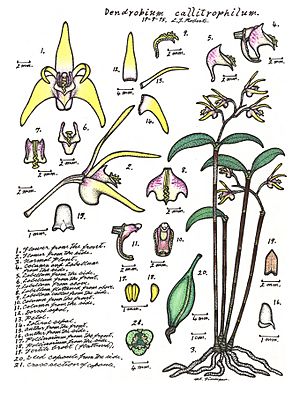Thin feather orchid facts for kids
Quick facts for kids Thin feather orchid |
|
|---|---|
 |
|
| Illustration by Lewis Roberts | |
| Conservation status | |
| Scientific classification | |
| Genus: |
Dendrobium
|
| Species: |
callitrophilum
|
| Synonyms | |
|
|
The thin feather orchid, also known as Dendrobium callitrophilum, is a special type of orchid. It is an epiphyte, which means it grows on other plants, like trees, but does not harm them. This orchid has thin, tube-like stems called pseudobulbs. It also has one or two thin, tough leaves. Its flowers are usually greenish-yellow. They have a special lip part called a labellum that can be cream or apricot-coloured. You can find this orchid growing in or near rainforests in certain parts of tropical North Queensland.
Contents
What the Thin Feather Orchid Looks Like
The thin feather orchid is a plant that grows on trees. It has special stems called pseudobulbs. These pseudobulbs are like thick tubes. They can be from 50 to 300 mm (about 2 to 12 inches) long. They are also very thin, only 1 to 3 mm (about 0.04 to 0.12 inches) wide.
This orchid usually has one or two leaves. These leaves are thin but feel a bit leathery. They are about 20 to 65 mm (about 0.8 to 2.6 inches) long. They are also 10 to 40 mm (about 0.4 to 1.6 inches) wide.
The orchid produces one or two flowering stems. These stems are 8 to 25 mm (about 0.3 to 1 inch) long. Each stem can hold up to six flowers. The flowers are greenish-yellow when they first open. As they get older, they turn a pretty apricot colour.
The flower has parts called sepals and petals. The sepals spread out wide. The top sepal is about 12 to 14 mm (about 0.5 inches) long. The side sepals are a bit shorter, about 11 to 13 mm (about 0.4 to 0.5 inches) long. The petals are similar in length to the side sepals. However, they are much narrower, only about 1.5 mm (about 0.06 inches) wide.
The labellum is the special lip of the orchid flower. It is about 5 to 6 mm (about 0.2 inches) long. It is also 6 to 7 mm (about 0.2 to 0.3 inches) wide. When new, it is cream-coloured. As it ages, it turns apricot with purplish stripes. The sides of the labellum stand up straight and are pointed. The middle part of the labellum points downwards. It has three small ridges, with the middle one being larger and wavy. This orchid usually blooms in August and September.
How the Thin Feather Orchid Got its Name
The scientific name for the thin feather orchid is Dendrobium callitrophilum. It was first officially described in 1989. Two botanists, Bruce Gray and David Jones, gave it this name. They found a sample of the orchid near Nitchigar Creek, which is close to a place called Tully Falls. They wrote about their discovery in a scientific paper. This paper was published in the Proceedings of the Royal Society of Queensland.
Where the Thin Feather Orchid Lives
The thin feather orchid grows on trees and shrubs. It especially likes to grow on Callitris macleayana trees. It also grows on different types of Austromyrtus plants.
You can find this orchid in tropical north Queensland. It grows in or very close to rainforest areas. It prefers to live at higher places. These places are usually between 760 and 1500 metres (about 2,500 to 4,900 feet) above sea level.
Protecting the Thin Feather Orchid
This beautiful orchid is considered "vulnerable." This means it is at risk of disappearing. The Australian Government lists it as vulnerable under a law called the Environment Protection and Biodiversity Conservation Act 1999.
Even though some groups of these orchids are safe in national parks, they still face dangers. These dangers include:
- Land clearing: When forests are cut down for farms or buildings.
- Changed fire regimes: When fires happen too often or not enough, which changes the environment.
- Illegal collecting: When people take the orchids from their natural homes without permission.
It is important to protect these orchids so they can continue to grow in the wild.


